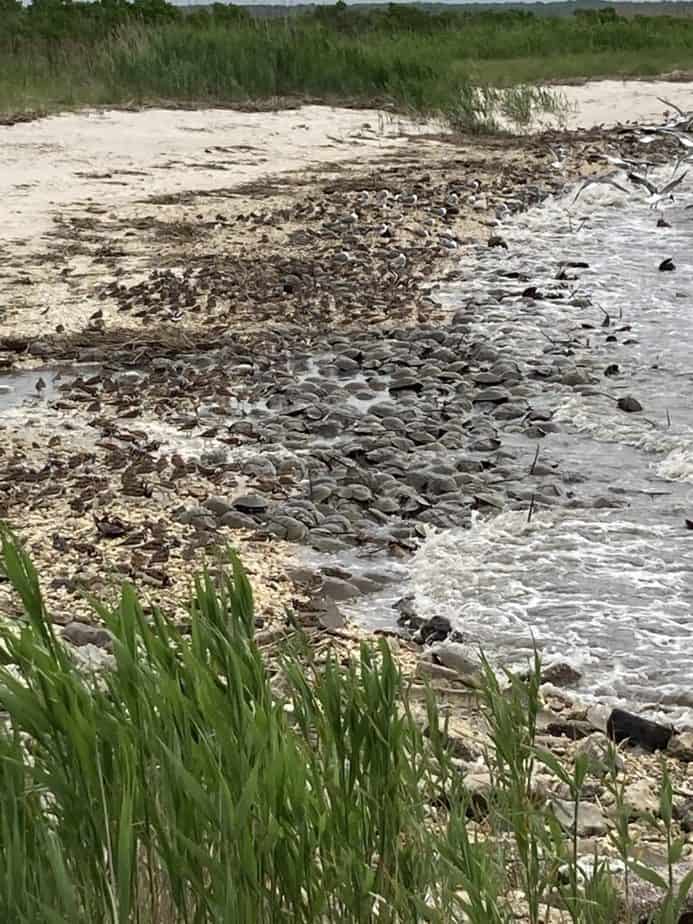Dear Shorebird Team,
This discussion is the kind that usually starts with ” do you want the bad news or good news.”
The bad news is bird numbers remain virtually unchanged. We conducted the first baywide ground, water, and air count yesterday and the numbers remain similar to our earlier estimates, about 5500 red knots and 9000 ruddy turnstones. I’ve included two tables below, the first from 2019 that shows on May 22, 2019; we had 30,880 red knots and 19,786 ruddy turnstones, so we are only at about 20% of the total from recent years for red knots and about half for ruddys. Semi-palmated sandpipers are similarly down, but the numbers are hard to compare. Our morning recce showed no difference from yesterday.
Table of Delaware bay count of red knots and ruddy turnstones in 2019 showing the count by May 22 at 30,880 red knots compared to 5500 in 2021.
This second table shows the numbers from last year. It was a tough year as we had to do a lot of the same work with a smaller crew, but COVID did not impair our counts. We had about 6000 knots in the bay in the areas we regularly searched, and then on our first baywide count, we found an additional 12,000 for a total of 19,397. You can see in the next count on May 26 numbers dropped to about 6000. 2020 was a bad year for the stopover because the peak of the spawning took place in late May-early June, so the birds that left after the May 24 count could find few eggs and left ( see the histogram below that shows the surface egg counts in May 2020).
Baywide count of red knot and ruddy turnstones in 2019 showing both the brief stay of about 13,000 knots and the drop of about 10,000 from 2019
So the good news is the spawn this year seems to be exceeding that of recent years. Below see the egg build-up at North Reeds and strands of eggs extending down the beach. Crabs seem to be spawning in all places now, including Thompsons’ beach (following picture). The egg counting team reports cluster densities of over 30/ sq meter in areas, and we expect spawning to continue through the full moon period of the next four days. We may be on track to higher cluster densities than in recent years ( see histogram below)
Consequently, the shorebirds that have already arrived this year appear to be gaining weight at above-average rates. The graph below for both red knots and ruddy turnstones shows the first two catches. Both arrived below average but, by the second catch, were above. We made a catch two days ago of 42 knots and 98 ruddy turnstones, and their weights were almost all above 160 grams, with several in the 190s.

Weight gain of Ruddy Turnstones and Red Knots for all years since 1997. The 2020 data is in pink and our first two catches in 2021 in red.
In summary, we are still waiting for the rest of the flock to arrive. The question is will the birds come or do they still exist. There are two reasons for concern.
- Most of the birds that arrived last year did not benefit from Delaware Bay eggs, all but 6000 or so, leaving before the spawn began. Allan Baker, in 2004 as well as subsequent studies, proved inadequate weight leaving Delaware Bay impacts survival negatively. To what extent is hard to know? In the early 2000’s numbers dropped from highs in the 50,000 to less than 20,000, so it could be severe. Or did last year’s lack of eggs cause birds to bypass the bay this year?
- The weather in the Caribbean in the last two years in early May has been difficult for any northbound shorebird of the last two years. This held up birds last year, but the peak was still 10,000 birds lower than 2019. Did they avoid the bay or were they lost at sea? This year similar weather blocked migration and may be the cause for our current low number. It’s still too early to tell, but the window will definitely close on our next bay-wide count on the 26th.
Finally, the red knots released with satellite transmitters provide new insights into the use of the bay. Stephanie programed the transmitters to record on daytime and one nighttime location so for the first time, we will know the roost locations. The map of three birds with data from yesterday and last night shows birds feeding on Thompsons beach roosting in Stone Harbor Point and another moving to Fortescue. This is the first image and the locations have to verify
Tomorrow we trap, Wednesday is the next count. Henrietta reports the DE team made a second catch of 65 knots.
Larry and the NJ Shorebird Team.



